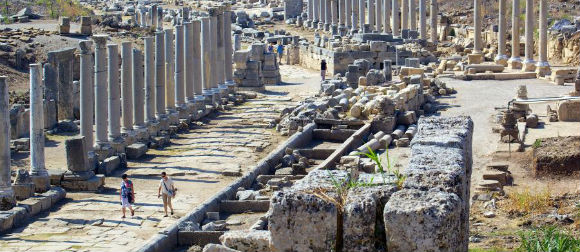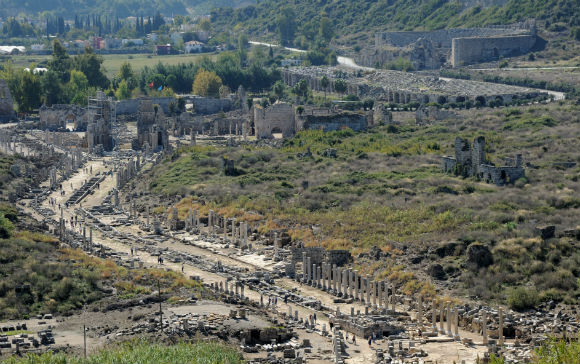The most impressive ruins of the Pamphylian coast are at Perge, at about 15 km east of Antalya. Perge was originally founded by the Hittites around 1500 BC. and was known as Parha. It was a successful trading centre near the Aksu (ancient Kestros or Cestrus) river when Alexander the Great arrived in 333 BC. He was welcomed in by the inhabitants and used Perge as base for his Anatolian campaigns. Alexander was followed by the Seleucids under whom the city prospered and Perge’s most celebrated inhabitant, the mathematician Apollonius from Perge lived and worked. Apollonius was a pupil of Archimedes and wrote a series of eight books on geometry. In 188 BC Perge became part of the Roman Empire during which the city flourished. Most of the surviving buildings date from this period.In 46 AD St. Paul started his journey in Perge (biblical Perga) and preached his first sermon here. Perge gradually declined during the Byzantine period, as the Aksu river silted, but remained inhabited until Selçuk times after which it became abandoned.
A visit to Perge starts by entering the archeological site through the Roman Gate, built during the reign of Septimius Severus (193-211 AD). Proceeding through the gate, to the right is the Agora or market place. This structure of 75 x 75 m dates back from the 2nd century AD. The center courtyard and shops were surrounded by a wide stoa, a covered walkway. The floor of the stoa and shops was made of colored mosaics. The agora was not only the centre of Perge’s trade, but was also a place for meetings as well as a forum for political, social, and philosophical discussions. The next building is the Hellenistic city gate that dates back to the 3rd century BC. This is certainly the most imposing building of the city and was cleverly designed to protect the city with its twin towers and its horseshoe-shaped courtyard at the back. It is thought that the towers had three floors and were crowned by a conical roof. In the year 121 AD, the horseshoe-shaped courtyard was rededesigned as a courtyard of honor. Behind the courtyard stood a triple arch. Around the arch there are about dozen inscriptions connected with Plancia Magna who lived in the 2nd century AD. She was the daughter of the governor, a priestess of Artemis Pergaia (Diana) and a benefactress to the city. Plancia Magna had the arch decorated with the statues of the emperors and their relatives.
After passing through the Hellenistic Gate and courtyard, one enters a broad, marble-paved double-colonnaded street measuring 300 meters in length that extends from the main gate to the acropolis. The street is 20 m wide and is divided in two by a 2 meter wide water channel running down the middle. At the end of the colonnaded street is the Nymphaeum, a triumphal fountain from where a stream flowed down into the water channel. The nymphaeum or nymphaion is an ornamental semicircular structure and dates from the reign of Emperor Hadrian (130-150 AD). A statue of a river god Kestros was located in the center of this huge fountain. Behind the nymphaeum is the acropolis with some remains of the Byzantine period. To the west of the nymphaeum are the remains of a palaestra dating from 50 AD and dedicated to the Emperor Cladius (41-54 AD).
Returning back to the entrance, there are the excavated Roman baths located southwest to the agora. Out of the site proper, is the horsehsoe-shaped stadium, the largest in Asia Minor, measuring 234 m by 34 m. The stadium had a seating capacity of 12,000 people supported by massive barrel-vaulted constructions. Just beyond the site entrance is also the theatre, which is of the Greco-Roman type and could seat 15,000 people. Unfortunately, it is for some time under reconstruction and unfortunately closed to visitors.
Perge,



Most impressive of all the historical sites around Antalya. Very close to the city (app 30 min drive). Well preserved and great for those who know the Bible and want to follow Paul's steps. Paul gave two sermons in Perge.
We went to a Roman ruin site where we discovered Greek ruins saw christian settlements and the great Roman baths. Yes it was a unique experience which stays with you for a long while.
At the onset all in mind was Friends, Romans and countrymen…. and when we left my 12 year old daughter was raving abou Heidies and Poseidon…
Personally this was not a good place to go. It lacked any form of structure. Maps or what was where would have been good. Pictures/models showing what it looked like in its day would have helped.
All it needed was a little bit of extra work to enable you to see what a wonderful and interesting place it would have…
If you like history then Perge is definitely worth seeing. It is a vast site dating back to the Roman era. You do need some imagination to recreate what was once clearly an amazing city, but it's a fascinating place.
Great to see and hear things to do with Their History. Lots of Photographic Opportunities.Would love to go again,but when its a little bit cooler.
After the grandeur of Ephesus and volumous Hierapolis, Perge can seem like a bit of a let down. But it is the best preserved and most extensive site near Antalya and if you are staying there you should go see this Roman City.
It has a beautifully preserved Agora (marketplace) with many standing columns that give a hint of the…
Perge is really a great place to visit. Of course Turkey and the Middle East have plenty of Roman ruins but I think that Perge is there in the top attractions. As usual you need a bit of culture to understand and "see" the Roman town but at the end of the day everything is there: the Agora and the…
This big Roman ruin city is comparable to Efesos and is still under excavation, so it grows by the day. Lots of daytrips go here, and it was perhaps the cultural highlight of our week in Antalya. Book a guided trip and experience it!
Excellent site. Be careful walking around, especially the hippodrome; take the entrance from the parking lot.
An amazingly extensive and well-preserved site that is still being excavated – fascinating!